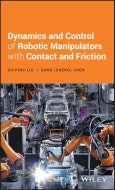A comprehensive guide to the friction, contact and impact on robot control and force feedback mechanism
Dynamics and Control of Robotic Manipulators with Contact and Friction offers an authoritative guide to the basic principles of robot dynamics and control with a focus on contact and friction. The authors discuss problems in interaction between human and real or virtual robot where dynamics with friction and contact are relevant. The book fills a void in the literature with a need for a text that considers the contact and friction generated in robot joints during their movements.
Designed as a practical resource, the text provides the information needed for task planning in view of contact, impact and friction for the designer of a robot control system for high accuracy and long durability. The authors include a review of the most up-to-date advancements in robot dynamics and control. It contains a comprehensive resource to the effective design and fabrication of robot systems and components for engineering and scientific purposes. This important guide:
- Offers a comprehensive reference with systematic treatment and a unified framework
- Includes simulation and experiments used in dynamics and control of robot considering contact, impact and friction
- Discusses the most current tribology methodology used to treat the multiple-scale effects
- Contains valuable descriptions of experiments and software used
- Presents illustrative accounts on the methods employed to handle friction in the closed loop, including the principles, implementation, application scope, merits and demerits
- Offers a cohesive treatment that covers tribology and multi-scales, multi-physics and nonlinear stochastic dynamics control
Written for graduate students of robotics, mechatronics, mechanical engineering, tracking control and practicing professionals and industrial researchers, Dynamics and Control of Robotic Manipulators with Contact and Friction offers a review to effective design and fabrication of stable and durable robot system and components.
Table of Contents
Preface ix
1 Introduction 1
1.1 Robot Joint Friction Modeling and Parameter Identification 1
1.2 Contact Perception in Virtual Environment 2
1.3 Organization ofThis Book 3
References 4
2 Fundamentals of Robot Dynamics and Control 9
2.1 Robot Kinematics 9
2.1.1 Matrix Description of Robot Kinematics 9
2.1.2 Homogeneous Transformation Matrices 12
2.1.3 Forward Kinematics 14
2.1.4 Inverse Kinematics 24
2.1.5 Velocity Kinematics 29
2.2 Robot Dynamics 30
2.3 Robot Control 31
2.3.1 Introduction 31
2.3.2 Trajectory Control 31
2.3.2.1 Point-to-Point Control 32
2.3.2.2 Trajectories for Paths Specified by Points 33
2.3.3 Interaction Control 38
2.3.3.1 Impedance Control 38
2.3.3.2 Hybrid Force-Position Control 38
References 39
3 Friction and Contact of Solid Interfaces 45
3.1 Introduction 45
3.2 Contact Between Two Solid Surfaces 46
3.2.1 Description of Surfaces 46
3.2.2 Contact Mechanics of Two Solid Surfaces 48
3.3 Friction Between Two Solid Surfaces 55
3.3.1 Adhesion 55
3.3.2 Dry Friction 65
3.3.2.1 Friction Mechanisms 65
3.3.2.2 Friction Transitions andWear 75
3.3.2.3 Static Friction, Hysteresis, Time, and Displacement Dependence 78
3.3.2.4 Effects of Environmental and Operational Condition on Friction 80
3.3.3 Liquid Mediated Friction 81
3.3.3.1 Stribeck Curve 81
3.3.3.2 Unsteady Liquid-Mediated Friction 84
3.3.3.3 Negative Slope of Friction-Velocity Curve 87
3.3.4 Friction Models 87
References 99
4 Friction Dynamics of Manipulators 115
4.1 Friction Models of Robot Manipulator Joints 115
4.2 Modeling Friction with Varied Effects 119
4.3 The Motion Equations of Dynamics of Robot Manipulators with Friction 123
4.3.1 The General Motion Equation of Robot Manipulators 123
4.3.2 The Motion Equation of Two-Link Robot Manipulators 130
4.4 Nonlinear Dynamics and Chaos of Manipulators 132
4.5 Parameters Identification 142
4.5.1 Identification of Dynamic Parameters 142
4.5.2 Identification of Parameters of Friction Models 146
4.5.3 Uncertainty Analysis 151
4.6 Friction Compensation and Control of Robot Manipulator Dynamics 153
References 158
5 Force Feedback and Haptic Rendering 175
5.1 Overview of Robot Force Feedback 175
5.2 GeneratingMethods of Feedback Force 177
5.2.1 SerialMechanism 178
5.2.1.1 Kinematics 178
5.2.1.2 Inverse Kinematics 179
5.2.1.3 Dynamics 181
5.2.2 Parallel Mechanism 182
5.2.2.1 KinematicsModel 182
5.2.2.2 Forward Kinematics 185
5.2.2.3 Inverse Kinematics 188
5.2.2.4 Dynamics Based on VirtualWork 190
5.2.3 Friction Compensation 194
5.3 Calculation of Virtual Force 197
5.3.1 Collision Detection 197
5.3.1.1 The Construction of the Bounding Box 199
5.3.1.2 Calculation of Distance between Bounding Boxes 202
5.3.2 Calculating the Model of Virtual Force 206
5.3.2.1 1-DoF Interaction 206
5.3.2.2 2-DoF Interaction 207
5.3.2.3 3-DoF Interaction 208
5.3.2.4 6-DoF Interaction 210
5.4 Haptic Display Based on Point Haptic Device 210
5.4.1 Human Tactile Perception 211
5.4.2 Haptic Texture DisplayMethods 211
References 214
6 Virtual Simulation of Robot Control 225
6.1 Overview of Robot Simulation 225
6.2 3D Graphic Environment 227
6.3 Virtual Reality−Based Robot Control 228
6.3.1 Overview of Virtual Reality 228
6.3.2 Overview of Teleoperation 229
6.3.3 Virtual Reality−Based Teleoperation 231
6.4 Augmented Reality−Based Teleoperation 233
6.4.1 Overview of Augmented Reality 233
6.4.2 Augmented Reality−Based Teleoperation 234
6.5 Task PlanningMethods in Virtual Environment 235
6.5.1 Overview 235
6.5.2 Interactive Graphic Mode 236
References 238
Index 247








